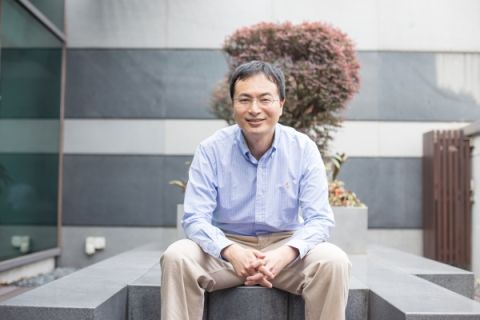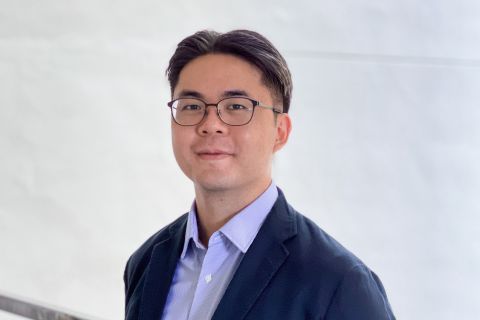
By Jovina Ang
SMU Office of Research – Since ancient times, religious beliefs and practices have been a powerful force in shaping morality, justice, values and the things that influence a society.
However, with increased secularism, does religion still play such a role?
To understand the role of religion in society, Assistant Professor Justin Tse decided to focus on the influence of Catholicism on ‘social dreaming’ – a term that defines an idealised vision of a society that is just, democratic and respectful of human rights, and governed by the rule of law.
In speaking to the Office of Research, he said: “Given Catholicism is one of the largest and most practised religions in the world, I thought that it would be a good place to start.”
In his latest research project titled “Catholic Talk, Social Dreaming: Civil Service Discourse in Ukraine and Hong Kong”, two social movements – one each in Ukraine and Hong Kong – were chosen to study the phenomenon. These two movements not only attracted a huge following of secular participants, they also garnered some support from the local Catholic church.
The first social movement that Professor Tse examined was the post-maidan Ukraine movement. In the period between November 2013 and February 2014, tens of thousands of people went to Maidan – the main and central square in Kyiv, to protest against President Viktor Yanukovych’s push for alignment with Russia rather than with the European Union. This movement attracted highly visible support from the local Catholic priests, who were frequently photographed and filmed by international media at the frontline of the anti-government protests that often turned violent.
The other social movement, which took place in Hong Kong from September to December 2014, drew parallels to Ukraine. While the cause was different, both secular participants and the local Catholic church promoted democracy, urging Beijing to adhere to the ‘one country, two systems’ constitution that was introduced after the cessation of British rule in Hong Kong.
Known as the Umbrella Movement as protestors used umbrellas to protect themselves against tear gas, pepper spray and police batons, this movement attracted support from the retired Cardinal Joseph Zen Ze-kiun, who was from the Catholic Diocese of Hong Kong.
Professor Tse said: “These two similar yet isolated movements provided a good test bed to determine the relationship between the Catholic church and the concept of social dreaming. In each of the movements, Catholic priests were drawn to the front line. They participated alongside the secular participants to push for what they deemed as the ideal social dreaming for their respective countries. They offered prayers. They appealed to the broader society to support the causes and so on.”
“While it was evident that the priests and the secular participants were aligned to the same cause in the two countries, what was not clear was whether there was a convergence or a divergence of views in the aftermath of these movements,” he continued.
The research
The research, which took place in 2021 and 2022, was led by Professor Tse and Halyna Herasym, a PhD candidate at the University College Dublin and a researcher at the Ukrainian Centre for Law and Crime Research.
The methodology used was a mixed method comprising 60 in-depth interviews (10 Catholic priests and 20 protestors in each location) and an examination of archival audiovisual data during and after the movements.
Part 1 of the research focused on getting insights from the Catholic priests whereas Part 2 recorded the secular participants’ experience in each location.
Given that both researchers are fluent in local languages, specifically in Ukrainian and Cantonese, they were able to draw out nuances and detect local inferences that might have been missed if the interviews were solely conducted in English.
Additionally, the research team took time to understand the role of the Vatican. Pope Francis, who came into papacy in 2013, is unlike the popes before him. He is a progressive pope and is not afraid to adapt the teachings of Catholicism to the modernised version of an ideal society.
Findings
The in-depth interviews revealed that both the Catholic priests and secular participants are aligned in terms of promoting a social dream and a society that is civil, democratic and just.
The research showed that there was trust bestowed on the local Catholic churches in their support for building a better future for the local communities.
Other than providing physical and spiritual support in the form of presence and prayers, the church was seen to provide material support to the protestors in their pursuit of social dreaming. By material, the church was seen to lend its buildings and infrastructure, for the protestors to use.
Professor Tse hastens to add that while church spaces became important as infrastructure for some of the movements, it does not represent complete alignment between the church and secular participants. Those involved in the movements tended to appropriate from the church, while the church as an institution was not always neatly aligned to their aims.
Additionally, what was visibly lacking in both movements was the support from the Vatican even though Pope Francis himself has promoted the concept of social dreaming at the global level, especially in the area of protecting human rights.
Next steps
While the research showed the importance of social dreaming between the local Catholic church and secular participants, what is still not clear is: What does an idealised vision of social dreaming look like?
This is the reason why Professor Tse is applying for the Ministry of Education Academic Research Funding (AcRF) Tier 1 grant to further the project.
He commented: “There are two routes that we could take to increase our understanding on the role of religion in influencing social dreaming. We could either expand our work by delving into the influencing roles of the different religions in the world, or we could go deeper by delving into the ways by which Catholicism is playing a part in social dreaming across the globe.”
“Depending on the outcomes from the research, I foresee many implications that we can apply from this work, of which, one entails getting policy makers to include religious input in developing policies to create a better future for the local communities”, he continued.
Back to Research@SMU May 2023 Issue
See More News
Want to see more of SMU Research?
Sign up for Research@SMU e-newslettter to know more about our research and research-related events!
If you would like to remove yourself from all our mailing list, please visit https://eservices.smu.edu.sg/internet/DNC/Default.aspx

